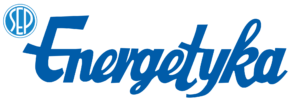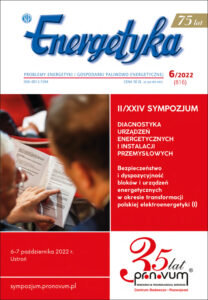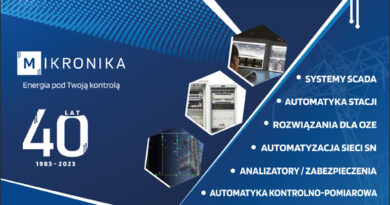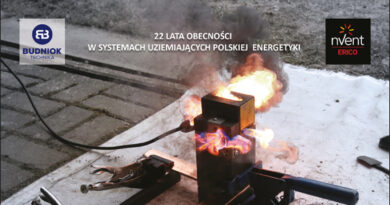June 2022, Issue 6 (816)
TABLE OF CONTENTS
POWER ENGINEERING AND NUCLEAR POWER
Krzysztof Rzymkowski
Nuclear propulsion ships – Japanese experience
Jakub Bernatt, Stanisław Gawron, Tadeusz Glinka, Artur Polak
Polarization tests of the OPI-type Bushing with DC voltages
BULLETIN OF PRO NOVUM
Jerzy Trzeszczyński
Improving the flexibility of 200 MW class units by using capabilities and reserves of the control-side as well as remaining life
Mateusz Kusibab, Marcin Hatłas, Wojciech Murzynowski, Paweł Zając
Digital infrastructure of diagnostic environment to support a Pro Novum Method on 200 MW power unit
Jerzy Trzeszczyński, Marcin Hatłas, Wojciech Murzynowski
The benefits of replacing the temperature criteria with stress criteria to ensure the safety and availability of power units operated in the control mode and with increased flexibility
Jerzy Trzeszczyński, Paweł Galbarczyk, Radosław Stanek, Wojciech Murzynowski
The results of the Pro Novum Method on the reference unit No. 1 in ENEA Elektrownia Połaniec SA – benefits and possibilities of its commercialization
Jubilee of the 35th anniversary of Przedsiębiorstwo Usług Naukowo-Technicznych „Pro Novum” sp. z o.o.
THROUGH THE EYE OF A WORLD TRAVELER
Stefan GIERLOTKA
Power engineering in Senegal
OVERTIME LECTURE….
Bogumił DUDEK
Historia (i polityka) kontrafaktyczna
SUMMARIES
Krzysztof Rzymkowski
Nuclear propulsion ships – Japanese experience
Characterised are four nuclear propulsion cargo ships: Savannah built in the USA, Otto Hahn from Germany, Siewmorput’ from the USSR and Mutsu built in Japan. Presented are attempts to introduce nuclear propulsion ships into merchant navy. Described in details is the history of such attempt on the example of the Japanese experimental ship Mutsu.
Keywords: nuclear propulsion cargo ships, nuclear propulsion ships in merchant navy, Mutsu ship
Jakub Bernatt, Stanisław Gawron, Tadeusz Glinka, Artur Polak
Polarization tests of the OPI-type Bushing with DC voltages
The bushings have an exceptionally high amount of paper-oil insulation. Under normal conditions, the insulator works with alternating voltage, and the on-line diagnostic parameter is tgδ. The assessment of the technical condition of an insulator based on tgδ is uncertain. The article presents the off-line DC test program, which includes three tests: charging the insulation system with the voltage Up and measuring the current I60, disconnection of the supply voltage and short circuit of the insulation system for the time tz, opening of the insulation system and measurement of the recovery process of the voltage uod(t) to the maximum value of Uod max. The diagnostic parameters are: test voltage Up, resistance R60, time of short-circuit tz, maximum value of the recovered voltage Uod max and time of the recovery of the voltage τod. These parameters, determined for the new insulator and recorded in its specification, constitute a fingerprint.
Keywords: bushing, equivalent diagram, insulation test, diagnostic parameters
Jerzy Trzeszczyński
Improving the flexibility of 200 MW class units by using capabilities and reserves of the control-side as well as remaining life
The acquired knowledge and experience moved Pro Novum to develop a Method, the main advantages of which are universality and low implementation costs, which means that it can be implemented with an economic benefit even on units whose further operation may be relatively short due to failure to meet all emission requirements and no benefits from the Power Market as well as special system services. The article presents the genesis, basic assumptions, implementation conditions, functional description and advantages of the Pro Novum Method.
Keywords: Pro Novum Method, universality, low implementation cost
Mateusz Kusibab, Marcin Hatłas, Wojciech Murzynowski, Paweł Zając
Digital infrastructure of diagnostic environment to support a Pro Novum Method on 200 MW power unit
The article describe a digital infrastructure of diagnostic environment was done to realized Pro Novum Method on reference power unit, which was realized in “Blocks 200+” competition. The article presents infrastructure of control and measurement system based on technical and process data. Pro Novum Method was applied using a specialized software and modules including virtual models of critical elements and process simulation.
Keywords: digital diagnostic environment, remote communication system, structure and process modelling, simulation of working conditions
Jerzy Trzeszczyński, Marcin Hatłas, Wojciech Murzynowski
The benefits of replacing the temperature criteria with stress criteria to ensure the safety and availability of power units operated in the control mode and with increased flexibility
The article presents an approach in which the temperature criteria specified in the formula of Thermal Restriction Blocks (Pol. BOT) were replaced with stress criteria generated in the Life Control Block (Pol. BKT). BKT analyzes on an ongoing basis, inter alia, the state of stresses in the critical elements of a power unit using their digital twins. The BKT approach allows for more accurate mapping of thermal states and stresses. In a gradually more and more advanced form, it has been developed in Pro Novum for many years. In particular, it accompanies the development of remote diagnostics systems as an indispensable tool for assessing the technical condition and predicting durability for units and devices operated in an increasingly flexible mode. The Life Control Block was developed under the ‘Program Bloki 200+’ (Power Units 200+ Program) and implemented on the reference block no.1 at ENEA Elektrownia Połaniec S.A.
Keywords: Durability Control Block (BKT), power unit, flexible operation, stress state in critical elements, digital twins, life prediction
Jerzy Trzeszczyński, Paweł Galbarczyk, Radosław Stanek, Wojciech Murzynowski
The results of the Pro Novum Method on the reference unit No. 1 in ENEA Elektrownia Połaniec SA – benefits and possibilities of its commercialization
In Pro Novum, as part of the ‘Program Bloki 200+’ (Power Units 200+ Program), a low-cost and universal method of increasing the flexibility of 200 MW class units has been developed, which increases their safety and availability, regardless of the intensity of the flexible operation. The Method developed by Pro Novum is based on the use of technical reserves of the power unit devices. Research and development works, during which the Pro Novum Method was verified on the real power unit have been completed, and the achievement of all the assumed indicators was confirmed during measurements carried out by an independent measurement company, in accordance with the requirements of the National Center for Research and Development. The Pro Novum Method can support the safety and availability of 200 MW power units in the period of transformation of the Polish power sector.
Keywords: Power Units 200+ Program, Pro Novum Method, increasing the unit flexibility, improving the safety and availability of 200 MW class units, the results of using the Pro Novum Method




